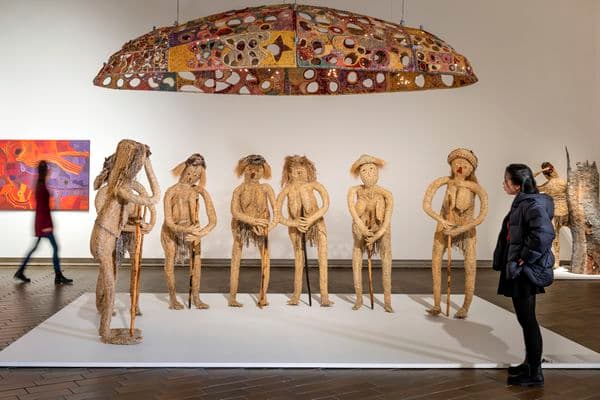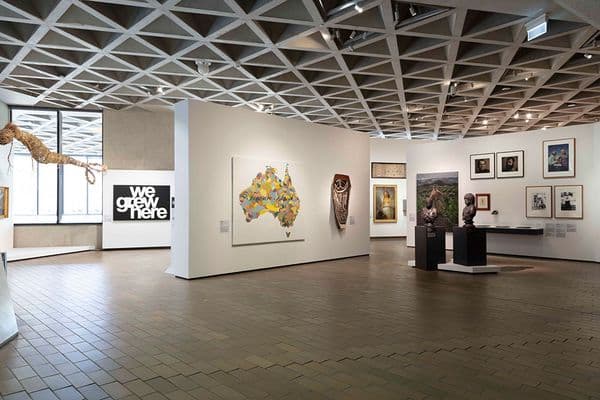The Life and Work of Wolfgang Sievers
26 Nov 1988 – 19 Feb 1989

Wolfgang Sievers, Sulphuric acid plant, E.Z. Industries, Hobart, 1959, National Gallery of Australia, Kamberri/Canberra, Purchased 1982. © Wolfgang Sievers/Copyright Agency.
Exhibition Pamphlet Essay
Wolfgang Sievers began his photographic career in Germany, but was forced to leave when Hitler’s Nazi government seized power. He has spent his mature years in Australia and during this time has made an extremely important — but still largely unacknowledged – contribution to Australian cultural life. This is the to present the full range of Sievers's work, and photographs taken in Germany, Portugal, Australia, many of which are being exhibited time. Sixty-three of these photographs have recently been acquired from the artist for the National Collection.
Born in Berlin in 1913, Sievers grew up in the heyday of the Weimar republic, when Berlin was regarded as the cultural and scientific centre of the world. He was introduced to the arts by his parents, who took him with them to concerts, plays, film screenings and art museums. His father, Professor Johannes Sievers, was arts adviser to the German foreign office from 1918 until his dismissal in 1933 by the National Socialists.
In 1911, Professor Sievers published sixty-five of his own photographs in a book of images from India. He encouraged his son to take up photography and gave him a box camera when he was about fifteen years old. On a holiday trip to Italy, in 1930, the young Sievers produced some promising photographs, among them a dramatic landscape of San Gimignano that is included in this exhibition. Some of his other early photographs were used to illustrate his father's books on the work of the prominent German architect Karl Friedrich Schinkel (1781–1841).
Following Adolf Hitlers rise to power in 1933, Sievers abandoned his archaeological studies at the university in Marburg. At his father’s suggestion he left Germany and spent over a year in Portugal, where he attempted to make a living as a photographer. Many of the photographs he took there depict old-world scenes — for example, the Moorish fortress at Sesimbra — in which time appears to have stood still.
Unable to support himself in Portugal, Sievers returned to Berlin. From 1936 to 1938 he attended the Contempora School for Applied Arts, initially as a student and then as a photography teacher. The head of the Photography Department at the School, Erich Balg, ran it along Bauhaus lines: lessons were held in the morning from 8.00 a.m. to 1.00 p.m., and after 2.00 p.m. the School's facilities were used as a commercial studio. This period marked Sievers's formal introduction to ideas championed at the Bauhaus, an institution that played a central role in the development of new theories of art from 1919 until it was closed by the Nazis in 1933. Of particular significance for Sievers's subsequent development was the Bauhaus belief that the fine and applied arts should be united, and that the artist should be directly involved in modern industrial production, thereby improving the quality of life.
While at the School, Sievers produced portraits, advertisements, and architectural and industrial studies. This work demonstrated his familiarity with, and mastery of, the stylistic devices of the New Photography, which had been developed during the 1920s by avant-garde artists, especially in the U.S.S.R. and Germany. Its hallmarks include the choice of everyday subject matter, the use of sharp focus, the arrangement of bold, simplified forms, and the favouring of dramatic vantage points, especially closeups, and shots looking up or down. Sievers applied the new points of view to a variety of subjects.
Stylistic aspects of the New Photography were quickly taken up as instruments for selling new products in magazines and catalogues, entering the service of capitalism as readily as they did socialism. Under Balg's supervision, Sievers produced some striking advertisements which displayed the prevailing advertising 'look'. While these photographs are very competent, they closely resemble other advertising work of the day. Other photographs that Sievers took in Germany deal more directly with what came to be his major concerns as a leading industrial photographer in Australia. In Total poverty in Berlin, Germany, 1933, a smiling, singing man and his musical machine merge together, and the Jewelworker in Pforzheim, Germany, 1937, is intimately involved with his work; it is the contact between the workers and their tools which is important to Sievers.
In 1938, Sievers was called up to the Luftwaffe, but managed to escape to England. With the support of three sponsors, one of whom was English-born photographer Axel Poignant (1906–1986), then resident in Western Australia, he immigrated to Australia and arrived in Sydney in September 1938, intending to settle there and practise as a photographer. The Pictorialist aesthetic was then dominant in Australian photography, and Sievers was relieved to meet Max Dupain (born 1911), whom he believed to be the only Australian photographer aware of modern ideas. Sievers was unsuccessful in securing employment with Russell Roberts (born 1904), who ran a photographic school in Sydney, and later in the year he moved to Melbourne and opened a photographic studio in South Yarra. His career was interrupted by the outbreak of the Second World War, and he volunteered for the Australian army, hoping to serve overseas. However, he spent the war years 1941 to 1945 in Albury in the army’s 4th Employment Company. He resumed his photographic practice in 1946 in a studio at 9 Collins Street, Melbourne, and began to specialize in architectural and industrial subjects, which he regarded as the most exemplary forms of the machine age.
Sievers's interest in modern architecture had been stimulated in his youth when he met Eric Mendelsohn (1887–1953), a leading German architect and his father’s friend. It found expression in architectural assignments in Australia during the 1950s, when he was commissioned to photograph private homes and buildings designed by architects such as Frederick Romberg, Robin Boyd, Roy Grounds and the firms Yuncken, Freeman, and Bates, Smart and McCutcheon. Since the 1960s, Sievers has seldom photographed architecture as he considers much new building to be uninspired and unoriginal. Instead, he has concentrated on photographing industrial subjects, a field that he has dominated with his strong — and often dramatic — graphic images. His approach marries the style of New Photography with a humanist vision first evident in the photographs he took in Germany in the 1930s. Sievers is principally concerned with the role workers have in the machine age; for him the crux of the work relationship is the physical contact between people and machines or their products. A number of photographs, such as Ropemaking, Miller Rope, Melbourne, 1962, focus on the workers hands as the source of skill.
In recent years, Sievers has been faced with the loss of his subject matter because of increasing automation and computerization in industry. In many of his photographs, workers no longer fill the frames, nor do they make significant physical contact with their tools. In Gears for mining industry, Vickers-Ruwolt, Melbourne, 1967, the white-coated man is dwarfed by the mighty machine. The displacement of people by machines has accelerated in the 1970s and 1980s, with huge numbers of factory workers being made redundant. Consequently, Sievers has become fascinated by the scale and drama of the gigantic machinery of the mining and oil industries, departing from his earlier humanist concerns.
Since the late 1960s, Sievers has worked principally in colour. However, it is only in the 1980s that colour photography has been accepted as having the same integrity as black and white photography, only now is colour work from the past being re-evaluated. For many years Sievers often used unnatural colour to dramatize his scenes, as do many younger contemporary artists today, and some of Sievers's photographs resemble film sets illuminated by strangely coloured lights.
In keeping with the Bauhaus heritage, Wolfgang Sievers has, throughout his career, sought to be a part of modern industrial life. As an artist he has not distanced himself from modern society, and the venues for his work have been trade displays and annual reports rather than art exhibitions. This exhibition recognizes the significance of Sievers's contribution to Australian photography, and secures for him a place in the histories of what are, in Australia, the separate worlds of industry and art.
Helen Ennis
I would like to thank Wolfgang Sievers for all his help in the preparation of the exhibition and this publication.











